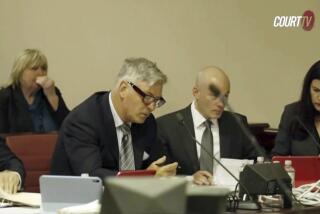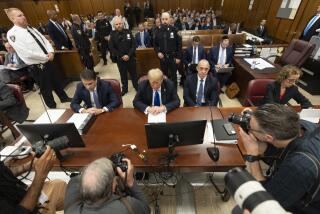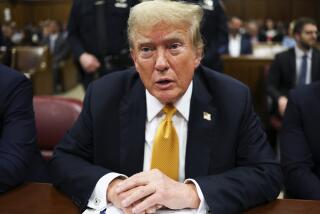Simpson Jury Could Begin Deliberating Next Week
- Share via
Testimony concluded in the O.J. Simpson civil trial Thursday with the promise that jurors will begin deliberations next week on the evidence delivered by 101 witnesses--from DNA scientists to grieving parents, from police detectives to the defendant himself.
The jurors will be asked to weigh more than 2,500 exhibits and 41 days of testimony spread out over the past three months. Their job: to decide whether Simpson is responsible for the slayings of Nicole Brown Simpson and Ronald Lyle Goldman.
If jurors do find Simpson liable, they must then determine how much he should pay Goldman’s parents to compensate them for the loss of their son’s love and companionship. (The Brown family is not asking for that kind of compensation.) They will also be asked to decide whether punitive damages are in order.
Both victims’ estates have filed claims for punitive damages, which are designed to punish the killer and deter future slayings. Nicole Simpson’s children with O.J. Simpson are the beneficiaries of her estate; Goldman’s parents are his legal heirs. If jurors elect to award punitive damages, a second phase of the trial would begin almost immediately. Both sides would present evidence about Simpson’s financial assets, and jurors would then return to the deliberation room to determine an appropriate dollar figure.
Most of the jurors kept poker faces Thursday afternoon when Superior Court Judge Hiroshi Fujisaki announced: “Ladies and gentlemen, that concludes the evidence in this case.” The lawyers, in contrast, sounded almost giddy as they ambled out of court, slapping backs and shaking hands.
The two sides will discuss jury instructions with the judge today, and will present closing arguments next Tuesday and Wednesday.
The plaintiffs concluded their rebuttal case Thursday with two familiar faces: photo analyst Gerald Richards and FBI footwear expert William Bodziak, who returned to the stand to testify about 30 full-length photos of Simpson at a 1993 football game. Richards concluded that the snapshots are authentic; Bodziak testified that in them, Simpson is wearing Bruno Magli shoes--the same Italian brand that left size-12 bloody footprints at the murder scene.
Simpson’s attorneys agree that the shoes in the photos are Bruno Maglis. Yet they insist the snapshots are phony.
The defense did not present any expert testimony Thursday suggesting that the 30 photos could be forgeries. Instead, they got Richards to acknowledge that a motivated forger with advanced technology could fool even veteran photo analysts. And they showed jurors a letter from the photographer’s agent peddling the right to broadcast the photos on TV for up to $18,000, suggesting that greed may have motivated someone to doctor the negatives to make it look as though Simpson were wearing Bruno Maglis.
Outside the jury’s presence, plaintiffs attorney Daniel Petrocelli responded by holding up an envelope that he said contained still more photos of Simpson wearing Bruno Maglis, taken by different photographers. He did not attempt to show those pictures to the jury.
Also Thursday, a molecular geneticist who spent more than 300 hours reviewing blood evidence in the Simpson case testified that he found “absolutely no evidence of any contamination whatsoever.” Bradley Popovich, the director of a DNA medical lab in Oregon, told jurors repeatedly that all the blood test results in the case are accurate, reliable and “unaffected by contamination.”
Popovich was hired by the prosecution in Simpson’s criminal trial, at a cost of $30,000, to review every aspect of the DNA evidence, a mammoth task that included visiting all three labs that handled blood samples, interviewing the scientists who performed the tests, and reading all lab data. Though his conclusions supported the integrity of the case against Simpson, the prosecution never called Popovich as a witness. The plaintiffs in the civil case, however, put him on the witness stand, where he refuted defense DNA expert John Gerdes’ testimony point by point.
On cross-examination, Popovich conceded that he has “observed contamination” before at the LAPD lab, which processed all the blood samples before parceling them out to other test sites. He also acknowledged that he has no idea what techniques were used to collect the evidence from the crime scene.
*
And, when pressed by defense attorney Phil Baker, Popovich testified that a blood stain on O.J. Simpson’s socks contained a very high concentration of DNA consistent with Nicole Brown Simpson’s. Popovich agreed that the stain was “consistent with” having been planted on the socks from a DNA-rich source, such as a reference vial of Nicole Simpson’s blood. (He also testified that it was “possible” that much DNA could have landed on the socks from blood splashed from a spurting wound during an assault.)
The defense has long argued that incriminating blood was planted on both the socks and the back gate of Nicole Simpson’s condominium.
Blood was not collected from the gate until two weeks after the slayings; no one even discovered blood on the socks until two months later. When the stains were finally processed, both the socks and the gate turned out to be laden with much higher concentrations of DNA than some other evidence in the case. And a defense toxicologist testified that both contained EDTA, a preservative used to keep the blood in test tubes from coagulating. The DNA from the stain on the back gate was found to be consistent with O.J. Simpson’s.
To rebut the frame-up theory, the plaintiffs brought in chemist Terry Lee, a research scientist at the City of Hope. Lee reviewed the EDTA data--which was compiled by an FBI agent in Washington--and concluded that the trace amounts of preservative in blood from the socks and the gate was the result of contamination in the lab, not planting by police.
“My opinion,” he said, “is that it could not have come from those test tubes.”
More to Read
Sign up for Essential California
The most important California stories and recommendations in your inbox every morning.
You may occasionally receive promotional content from the Los Angeles Times.










